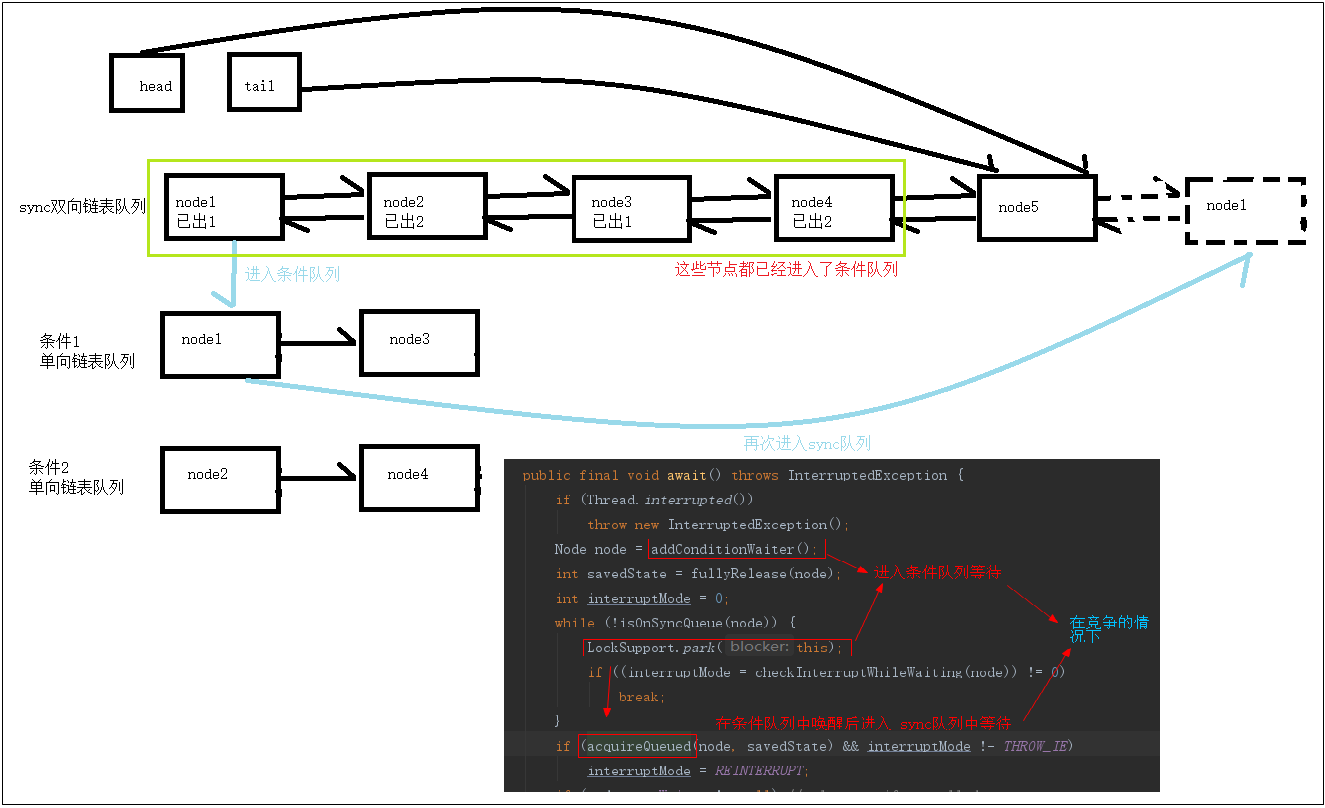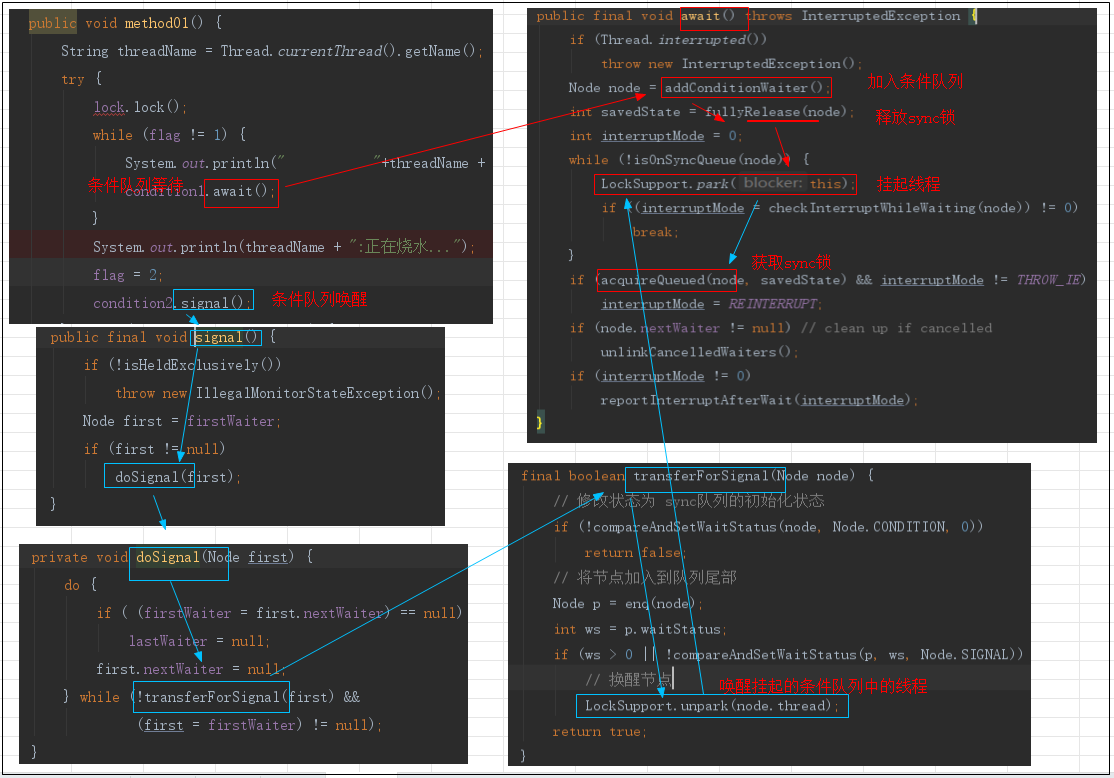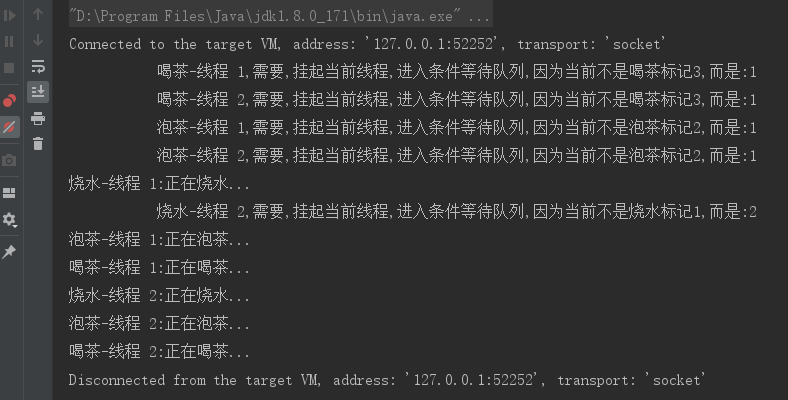ReentrantLock之Condition源码解读
1.背景
阅读该源码的前提是,已经阅读了reentrantLock的源码!
2.await源码解读
condition代码理解的核心,其实就是理解到:
线程节点如何从sync双向链表队列到指定的条件队列中,
然后又如何从条件队列中到sync双向链表队列的
一定要先把下面的2个图理解到,再去看源码和断点调试就很容易理解了
核心逻辑图:

核心代码逻辑图:

2.1.await方法详解
代码解读:
/** * 进入条件等待 */ public final void await() throws InterruptedException { // 是否有中断标记 if (Thread.interrupted()) throw new InterruptedException(); // 将线程加入到条件等待队列 Node node = addConditionWaiter(); /* fullyRelease(node) 释放锁并唤醒后继节点 这里要结合ReentrantLock来理解,执行到这里说明是获取到了锁的, 这里就是要释放ReentrantLock锁,然后进入到条件队列中等待*/ int savedState = fullyRelease(node); // interruptMode =0表示没有中断, interruptMode =1表示退出时重新中断 ,interruptMode=-1表示退出时抛异常 int interruptMode = 0; while (!isOnSyncQueue(node)) { // 在条件队列中等待 LockSupport.park(this); // checkInterruptWhileWaiting(node)返回0,表示没有中断 if ((interruptMode = checkInterruptWhileWaiting(node)) != 0) break; } // acquireQueued(node, savedState) 从sync队列中重新获取锁,并处理中断标记 if (acquireQueued(node, savedState) && interruptMode != THROW_IE) interruptMode = REINTERRUPT; // node结点不是最后一个结点,清除条件队列中无效的节点 if (node.nextWaiter != null) // clean up if cancelled unlinkCancelledWaiters(); // 重新处理中断,具体中断方式取决于 interruptMode 的值, // interruptMode =1表示退出时重新中断 ,interruptMode=-1表示退出时抛异常int interruptMode = 0; if (interruptMode != 0) reportInterruptAfterWait(interruptMode); }
2.2.addConditionWaiter方法详解
代码解读:
/** * 添加新的节点到条件队列 * 这里的条件队列是 单链表,不是双链表 * CONDITION = -2 表示是条件队列 */ private Node addConditionWaiter() { Node t = lastWaiter; // t.waitStatus != Node.CONDITION ?? 这个条件的作用 if (t != null && t.waitStatus != Node.CONDITION) { // 去掉取消节点 unlinkCancelledWaiters(); // 将取消的节点,去掉后,尾节点可能会变 t = lastWaiter; } Node node = new Node(Thread.currentThread(), Node.CONDITION); if (t == null) // 第一次进入条件队列 firstWaiter = node; else // 将当前节点放在尾节点之后 t.nextWaiter = node; // 设置新的尾节点 lastWaiter = node; // 返回当前节点 return node; }
2.3.fullyRelease方法详解
代码解读:
/** * 释放锁,并唤醒后继节点 * * @param node * @return */ final int fullyRelease(Node node) { boolean failed = true; try { // 获取当前资源状态 int savedState = getState(); // release(savedState) 释放锁并唤醒后继节点 if (release(savedState)) { failed = false; return savedState; } else { throw new IllegalMonitorStateException(); } } finally { // 释放锁失败节点取消 if (failed) node.waitStatus = Node.CANCELLED; } }
2.4.isOnSyncQueue方法详解
代码解读:
/** * 判定节点是否在sync队列中 * * @param node * @return */ final boolean isOnSyncQueue(Node node) { // 如果节点标记位是CONDITION = -2的状态 或者 没有前继节点,说明节点不在队列中 if (node.waitStatus == Node.CONDITION || node.prev == null) return false; // 如果下一个节点不为空说明节点在队列里面 if (node.next != null) // If has successor, it must be on queue return true; // 遍历sync队列,查看节点是否在队列里面 return findNodeFromTail(node); }
2.5.findNodeFromTail方法详解
代码解读:
/** * 遍历节点,查看传入的节点是否在队列里面,在里面返回true * * @param node * @return */ private boolean findNodeFromTail(Node node) { Node t = tail; for (; ; ) { if (t == node) return true; if (t == null) return false; // 从后往前遍历,还记得之前我们在讲ReentrantLock的源码时说过为什么要从后往前遍历么? t = t.prev; } }
2.6.checkInterruptWhileWaiting方法详解
代码解读:
/** * // 该模式意味着在退出等待时重新中断 * private static final int REINTERRUPT = 1; * // 该模式意味着在退出等待时抛出InterruptedException * private static final int THROW_IE = -1; * * @param node * @return */ private int checkInterruptWhileWaiting(Node node) { // 当前线程没有被中断直接返回0 // 当前线程已经被中断了的话 return Thread.interrupted() ? // 取消时重新入队列成功,标记为退出时抛出异常 // 取消时重新入队列失败,标记位退出时重新中断 (transferAfterCancelledWait(node) ? THROW_IE : REINTERRUPT) : 0; }
2.7.transferAfterCancelledWait方法详解
代码解读:
/** * 条件等待队列中的节点如果已经被取消,将节点添加到sync队列的尾部 * * @param node * @return 节点添加到尾部成功返回true, 否则返回false */ final boolean transferAfterCancelledWait(Node node) { // 初始化节点 if (compareAndSetWaitStatus(node, Node.CONDITION, 0)) { // 将节点添加到尾部 enq(node); // 添加到队列成功返回true return true; } // 判断节点是否在Sync队列里面 while (!isOnSyncQueue(node)) // 不在队列里面则等待,直到线程执行完成 Thread.yield(); // 添加失败,返回false return false; }
2.8.unlinkCancelledWaiters方法详解
代码解读:
/** * 作用:删除单项向链表中已经取消的节点,即状态不等于2的节点 * 这是典型单向链表删除节点的逻辑,如果对这个段代码不是很理解, * 可以查看之前的数据结果部分 */ private void unlinkCancelledWaiters() { Node t = firstWaiter; Node trail = null; while (t != null) { Node next = t.nextWaiter; if (t.waitStatus != Node.CONDITION) { // 断开连接,帮助GC回收 t.nextWaiter = null; if (trail == null) // 重新定义头结点 firstWaiter = next; else trail.nextWaiter = next; if (next == null) // 最后的有效尾节点 lastWaiter = trail; } else { trail = t; } // 指针后移 t = next; } }
2.9.reportInterruptAfterWait方法详解
代码解读:
/** * 中断的具体处理方式 * interruptMode =1表示退出时重新中断 ,interruptMode=-1表示退出时抛异常 * * @param interruptMode * @throws InterruptedException */ private void reportInterruptAfterWait(int interruptMode) throws InterruptedException { if (interruptMode == THROW_IE) // 抛出异常的处理方式 throw new InterruptedException(); else if (interruptMode == REINTERRUPT) // 自我中断的处理方式 selfInterrupt(); }
2.10.selfInterrupt方法详解
代码解读:
/** * 当前线程执行中断处理 */ static void selfInterrupt() { Thread.currentThread().interrupt(); }
3.signal源码解读
3.1.signal源码解读
代码:
/** * 唤醒条件队列中的节点 */ public final void signal() { // 检查当前线程是否是拥有锁的线程 if (!isHeldExclusively()) throw new IllegalMonitorStateException(); Node first = firstWaiter; if (first != null) // 执行唤醒方法 doSignal(first); }
3.2.isHeldExclusively源码解读
代码:
/** * 判定当前线程是否是拥有锁的线程 * @return */ protected final boolean isHeldExclusively() { return getExclusiveOwnerThread() == Thread.currentThread(); }
3.3.doSignal源码解读
代码:
/** * 执行唤醒条件队列中的节点 * @param first */ private void doSignal(Node first) { do { // 这个if的判定就是检查条件队列中是否还有节点,如果没有了,就将lastWaiter设置为null if ( (firstWaiter = first.nextWaiter) == null) lastWaiter = null; // 第一个节点出队列后,断开引用 first.nextWaiter = null; } while (!transferForSignal(first) && (first = firstWaiter) != null); }
3.4.transferForSignal源码解读
/** * 唤醒条件队列中的节点--> 到 sync对列中去 * @param node * @return */ final boolean transferForSignal(Node node) { // 修改状态为 sync队列的初始化状态 if (!compareAndSetWaitStatus(node, Node.CONDITION, 0)) return false; // 将节点加入到队列尾部 Node p = enq(node); int ws = p.waitStatus; if (ws > 0 || !compareAndSetWaitStatus(p, ws, Node.SIGNAL)) // 换醒节点 LockSupport.unpark(node.thread); return true; }
4.测试
不论你是否理解了源码,都建议大家多使用断点调试查看
节点是如何进入队列,
如何出队列,
如何挂起线程,
如何唤醒线程的.....
测试代码

package com.my.aqs.condition; import java.util.concurrent.locks.Condition; import java.util.concurrent.locks.Lock; import java.util.concurrent.locks.ReentrantLock; public class ConditionTest { // 功能标记位 private int flag = 1; // 创建非公平锁 private Lock lock = new ReentrantLock(false); // 条件锁1-烧水 private Condition condition1 = lock.newCondition(); // 条件锁2-泡茶 private Condition condition2 = lock.newCondition(); // 条件锁3-喝茶 private Condition condition3 = lock.newCondition(); /** * 功能:烧水 */ public void method01() { String threadName = Thread.currentThread().getName(); try { lock.lock(); while (flag != 1) { System.out.println(" "+threadName + ",需要,挂起当前线程,进入条件等待队列,因为当前不是烧水标记1,而是:" + flag); condition1.await(); } System.out.println(threadName + ":正在烧水..."); // System.out.println(threadName + ":烧水完成,唤醒泡茶线程"); flag = 2; condition2.signal(); } catch (InterruptedException e) { e.printStackTrace(); } finally { lock.unlock(); } } /** * 功能:泡茶 */ public void method02() { String threadName = Thread.currentThread().getName(); try { lock.lock(); while (flag != 2) { System.out.println(" "+threadName + ",需要,挂起当前线程,进入条件等待队列,因为当前不是泡茶标记2,而是:" + flag); condition2.await(); } System.out.println(threadName + ":正在泡茶..."); // System.out.println(threadName + ":泡茶完成,唤醒喝茶线程"); flag = 3; condition3.signal(); } catch (InterruptedException e) { e.printStackTrace(); } finally { lock.unlock(); } } /** * 功能:喝茶 */ public void method03() { String threadName = Thread.currentThread().getName(); try { lock.lock(); while (flag != 3) { System.out.println(" "+threadName + ",需要,挂起当前线程,进入条件等待队列,因为当前不是喝茶标记3,而是:" + flag); condition3.await(); } System.out.println(threadName + ":正在喝茶..."); // System.out.println(threadName + ":喝茶完成,唤醒烧水线程"); flag = 1; condition1.signal(); } catch (InterruptedException e) { e.printStackTrace(); } finally { lock.unlock(); } } /** * 睡眠时间是为了让线程按照这个顺序进入队列等待 喝茶->泡茶->烧水 * @param args */ public static void main(String[] args) { ConditionTest conditionTest = new ConditionTest(); for (int i = 1; i <= 2; i++) { // 烧水 new Thread(() -> { try { Thread.sleep(5*1000L); } catch (InterruptedException e) { e.printStackTrace(); } conditionTest.method01(); }, "烧水-线程 " + i).start(); // 泡茶 new Thread(() -> { try { Thread.sleep(5*100L); } catch (InterruptedException e) { e.printStackTrace(); } conditionTest.method02(); }, "泡茶-线程 " + i).start(); // 喝茶 new Thread(() -> { try { Thread.sleep(100L); } catch (InterruptedException e) { e.printStackTrace(); } conditionTest.method03(); }, "喝茶-线程 " + i).start(); } } }
断点调试图:

测试结果:






 浙公网安备 33010602011771号
浙公网安备 33010602011771号